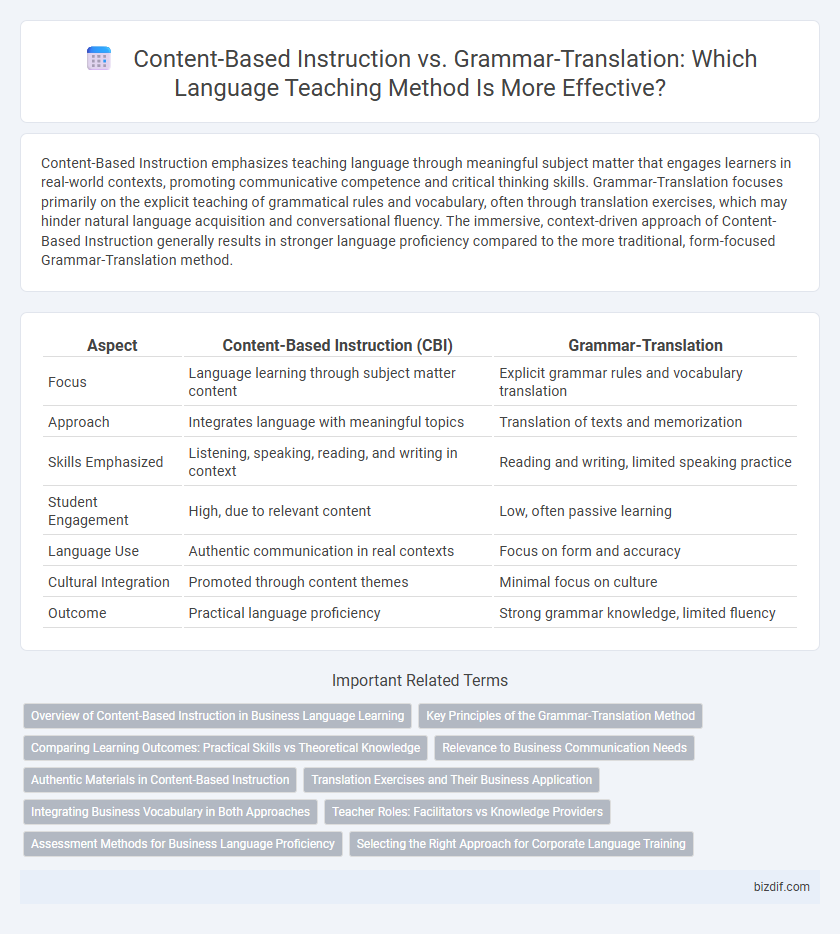Content-Based Instruction emphasizes teaching language through meaningful subject matter that engages learners in real-world contexts, promoting communicative competence and critical thinking skills. Grammar-Translation focuses primarily on the explicit teaching of grammatical rules and vocabulary, often through translation exercises, which may hinder natural language acquisition and conversational fluency. The immersive, context-driven approach of Content-Based Instruction generally results in stronger language proficiency compared to the more traditional, form-focused Grammar-Translation method.
Table of Comparison
| Aspect | Content-Based Instruction (CBI) | Grammar-Translation |
|---|---|---|
| Focus | Language learning through subject matter content | Explicit grammar rules and vocabulary translation |
| Approach | Integrates language with meaningful topics | Translation of texts and memorization |
| Skills Emphasized | Listening, speaking, reading, and writing in context | Reading and writing, limited speaking practice |
| Student Engagement | High, due to relevant content | Low, often passive learning |
| Language Use | Authentic communication in real contexts | Focus on form and accuracy |
| Cultural Integration | Promoted through content themes | Minimal focus on culture |
| Outcome | Practical language proficiency | Strong grammar knowledge, limited fluency |
Overview of Content-Based Instruction in Business Language Learning
Content-Based Instruction (CBI) in business language learning integrates language acquisition with subject matter relevant to specific industries, enhancing practical communication skills in professional contexts. This approach emphasizes immersive learning through real-world business materials such as reports, presentations, and negotiations, promoting functional language use over rote memorization. CBI fosters deeper engagement and retention by aligning language tasks with authentic business scenarios, contrasting with the Grammar-Translation method's focus on isolated grammar rules and literal translation exercises.
Key Principles of the Grammar-Translation Method
The Grammar-Translation Method emphasizes explicit teaching of grammatical rules and vocabulary through direct translation between the target language and the native language. It prioritizes reading and writing skills, often neglecting speaking and listening comprehension. Accuracy and memorization of linguistic forms are central to this method, with exercises focused on sentence parsing and translation drills.
Comparing Learning Outcomes: Practical Skills vs Theoretical Knowledge
Content-Based Instruction enhances practical language skills by immersing learners in meaningful communication and real-world contexts, promoting active usage and comprehension. Grammar-Translation focuses on theoretical knowledge of language rules and vocabulary, often emphasizing reading and translation rather than speaking or listening. Studies show learners in Content-Based Instruction programs typically achieve greater fluency and conversational competence, while Grammar-Translation learners excel in grammatical analysis and written accuracy.
Relevance to Business Communication Needs
Content-Based Instruction emphasizes practical communication skills by integrating language learning with real-world business topics, enhancing learners' ability to navigate professional environments effectively. Grammar-Translation focuses primarily on linguistic accuracy and translation skills, which may not directly address the immediate communication demands of business settings. Business professionals benefit more from Content-Based Instruction as it fosters contextual understanding and functional language use essential for workplace interactions.
Authentic Materials in Content-Based Instruction
Content-Based Instruction (CBI) emphasizes the use of authentic materials such as newspapers, videos, and real-life texts to enhance language learning by providing meaningful context and cultural relevance. This approach contrasts with Grammar-Translation, which relies primarily on textbook exercises and translated sentences, limiting exposure to natural language use. Authentic materials in CBI promote communicative competence and critical thinking, enabling learners to engage with language as it is used in everyday situations.
Translation Exercises and Their Business Application
Translation exercises in Content-Based Instruction (CBI) emphasize contextual understanding and practical communication skills, enhancing learners' ability to apply language in real-world business scenarios. Grammar-Translation methods focus on direct translation and grammatical accuracy, which may limit spontaneous language use and hinder business communication efficacy. CBI's integration of subject matter content with language learning improves proficiency in industry-specific terminology, making it more suitable for professional translation tasks and corporate training programs.
Integrating Business Vocabulary in Both Approaches
Content-Based Instruction integrates business vocabulary through authentic materials and real-world tasks, fostering practical language use in professional contexts. Grammar-Translation emphasizes business terms via direct translation exercises and vocabulary memorization, prioritizing accuracy over communicative competence. Both approaches can be tailored to enhance business language proficiency, with Content-Based Instruction promoting contextual understanding and Grammar-Translation focusing on explicit linguistic knowledge.
Teacher Roles: Facilitators vs Knowledge Providers
Content-Based Instruction positions teachers as facilitators who guide language learning through meaningful subject matter, fostering interactive and communicative skills. In contrast, Grammar-Translation treats teachers as knowledge providers, emphasizing explicit grammar rules and vocabulary memorization with a more authoritative classroom role. This shift impacts student engagement, promoting deeper comprehension and practical language use in Content-Based Instruction.
Assessment Methods for Business Language Proficiency
Content-Based Instruction assesses business language proficiency through authentic tasks such as presentations, reports, and role-plays that simulate real workplace scenarios, emphasizing communicative competence and practical application. Grammar-Translation relies heavily on written tests, including translation exercises, grammar drills, and vocabulary recall, prioritizing accuracy in grammatical structures over functional usage. Effective assessment in business language instruction integrates performance-based evaluations to measure both language skills and subject matter understanding.
Selecting the Right Approach for Corporate Language Training
Content-Based Instruction (CBI) emphasizes practical language use through industry-specific materials, making it ideal for corporate language training where contextual relevance enhances employee engagement and skill retention. In contrast, the Grammar-Translation method focuses on rote memorization of grammar rules and vocabulary, which may hinder real-world communication skills essential in professional environments. Choosing CBI supports immersive learning tailored to corporate sectors, fostering better language proficiency aligned with workplace demands.
Content-Based Instruction vs Grammar-Translation Infographic

 bizdif.com
bizdif.com